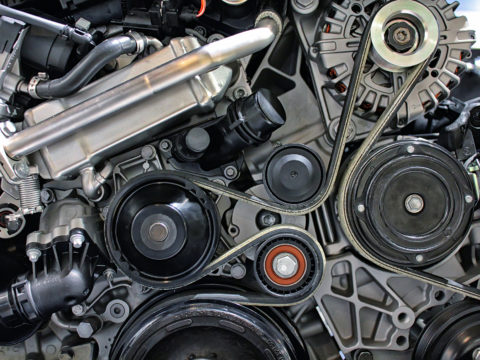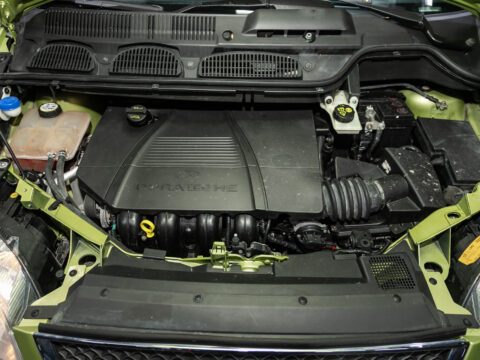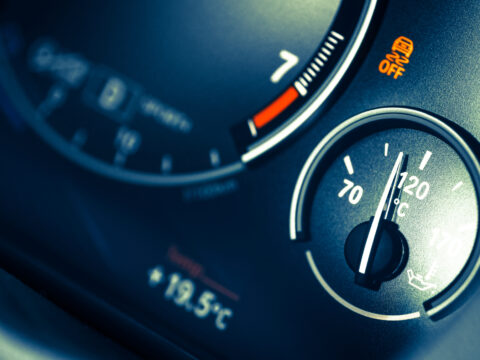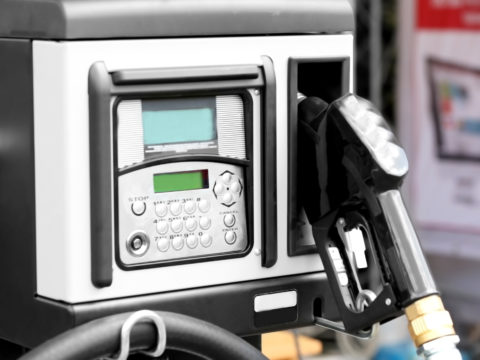Having your car shaking at idle can be a cause for concern, regardless of what make and model you drive. While most cars shouldn’t do this, there are several reasons it can happen, and each requires special attention.

Contents
Is It Normal for Car to Shake When Idle?
The short answer is yes. Whether they are automatic or manual transmission, most cars will shake a bit when at idle. This can be caused by the alignment and orientation of the engine and its components to the car’s chassis and body and manufacturing tolerances among those components themselves, such as bearings. Usually, this shaking is not noticeable, but it is essential to know that the car is designed this way.
However, if your car idles rough, has trouble starting, or shakes noticeably when you’re stopped for more than a few seconds, it’s time to investigate. Problems with the engine mounts could be making your car shake at idle.
Reasons Your Car Idles Rough but Drives Smooth
There are several reasons why a car might shake at idle but be smooth while driving. Below are eight causes of your car shaking at idle but smoothing out while driving.
Loose Gas Cap
The gas cap is one of the most common causes of a rough idle because if it isn’t on tightly enough, it can cause air to leak into the intake. When that happens, your engine has to work harder to keep running.
This is because it is running in a vacuum created by the intake, without any outside air, it needs to force into that space. It can also be due to carbon lock when the gas cap has been on too tight for too long, and some of the fuel evaporates into carbon particles instead of being burned cleanly. That makes everything more difficult, especially starting the car.
The best way to know that your gas tank is the culprit is to check your fuel cap and replace it if it looks fine. The cost of a gas cap is minimal compared to an engine rebuild due to carbon lock, so add one to your cart today, and you’ll be glad you did.
Worn Throttle Position Sensor
A faulty or worn throttle position sensor can cause issues with the car’s idle. It might not determine where it is in its rotation, which means the engine keeps trying to increase speed and doesn’t know when to stop. That can make for a rough ride at idle.
A throttle position can get worn when the throttle cable is adjusted too tightly, and it can cause the throttle position sensor not to work as efficiently as it should. Additionally, it can have the same effect as a loose gas cap, with air entering through an ineffective seal.
Bad or Faulty Idle Air Control Valve
The idle air control valve is responsible for controlling the amount of air entering the engine at idle. If it fails, your car will run rough since it won’t be getting enough oxygen to burn all the fuel in the cylinders.
The valve also contains a small vacuum controlled by an engine vacuum. When it’s not working or something like a hose breaks, the engine will continue to idle but irregularly since there is an absence of vacuum.
A faulty accelerator position sensor can make your car shake idle if it doesn’t read how far the accelerator is being pressed. It means the vehicle wants to speed up more than it should when it’s not supposed to, so your engine might run rough while at idle.
Another effect can be a delayed response when you press on the gas, meaning instead of speeding up smoothly, the car lurches forward or backward since it takes some time for the vehicle to react to your command.
A faulty idle air control valve can cause a rough idle and the other symptoms mentioned above. When it’s not working correctly, it will prevent the engine from maintaining a smooth idle speed. It can also be caused by vacuum leaks or problems with various hoses and connections throughout the intake manifold.
Faulty Fuel Pressure Regulator/Ignition Control Module
If the fuel pressure regulator isn’t working correctly, it can cause issues with your car’s idle. This is because it regulates the amount of gas that enters the engine at idle. If there’s not enough fuel entering the cylinders, they won’t have enough air to combust and run rough.
One sign that a fuel pressure regulator might be faulty is if the car has a rough idle even when it’s in gear and not pressing on the accelerator.
A faulty ignition control module can cause issues with your car shaking at idle because it prevents your engine from starting. It does this by sending out a signal that tells the fuel injectors when to fire so the cylinders can create the compression required to start.
If it’s not working, you’ll often notice other issues like your car dying at stop signs or red lights because there won’t be enough power to turn over the engine.
Oxygen Sensor
An oxygen sensor controls exhaust gas levels in your vehicle to make sure it doesn’t have too much or too little oxygen. It is essential during idle because your car’s computer relies on this information to help determine the optimal air and fuel ratio.
If it doesn’t know what the levels are supposed to be, it can cause all sorts of different problems like a rough idle. A faulty oxygen sensor will also make your car more difficult to start since it doesn’t have all of the information required to determine when it should fire.
You’ll have an idea that the shaking at idle could be your oxygen sensor if it happens, particularly when you’re idling or if your fuel mileage has dropped. If the oxygen sensor fails, it will send incorrect information to the car’s computer, preventing it from being able to determine if your fuel ratio is correct.
Dirty Throttle Body or Sensor
A dirty throttle body can cause your car to shake at idle because it prevents air from entering your engine. In addition, if there’s dirt on the outside of the throttle plate, then your engine won’t receive enough oxygen and will run too lean or too rich.
It might also make your car more difficult to start if enough air is sent through during ignition. The best way to fix this problem is by cleaning the throttle body out with an aerosol cleaner so that there are no more restrictions on airflow.
With a faulty or dirty throttle position sensor, your car’s computer won’t have accurate information about how far you’re pressing on the gas pedal. It will continue to send your car’s engine the incorrect amount of fuel even when you’re not pressing on the accelerator, which means it will run rough at idle. It often happens after oil changes since dirty oil can get on this sensor and cause its functions problems.
Loose Battery Cables
If your battery cables are loose, there won’t be enough power to help get the engine started. It can cause all sorts of issues like a rough idle or even prevent the car from starting at all. Since you’re working with an electrical system, everything must be connected tightly so electricity can flow freely between components. If you notice any connectors aren’t tightened down properly after changing your battery, this could be causing your issue.
It could also lead to misfires. If your car has misfired, then it might shake at idle because the incorrectly firing cylinders don’t create enough compression for the engine to operate smoothly. When you press on the gas pedal to speed up, these problems will go away since it can use the extra power to run correctly. If you suspect bad spark plugs or wires, then be sure to check them out first before replacing any other parts of your ignition system.
Camshaft Timing Chain
If your car has a timing chain, you might have a faulty timing chain tensioner. This part provides the resistance needed to keep your camshafts in place, so they don’t move out of sync with your pistons and valves.
Any problems with this tensioner will cause rough idle or even prevent your car from starting since it can’t be appropriately timed. If you need to replace this part, make sure to use only OEM components because they’re designed specifically for your vehicle.
Additionally, a bad crankshaft position sensor will tell your car’s computer that the engine is idling when it isn’t, which can lead to all sorts of issues like a rough idle or misfires. It works by giving the computer an accurate reading about where the crankshaft is in its rotation to set the timing chain correctly. If you find that this sensor isn’t working correctly, then make sure to replace it with a genuine OEM part since remanufactured components aren’t designed for your car.
Faults in these engine parts could also lead to an engine vacuum leak. An engine vacuum leak can cause rough idle because there won’t be enough power entering the engine to function correctly while idling.
It will also manifest as a misfire and might prevent your car from starting if there’s too much pressure building up inside of the cylinders and they’re not able to release it once combustion begins. You’ll need to inspect all of your vehicle’s hoses and other parts that might have any cracks or other problems that could let air escape without resistance.

How to Fix Car Vibration
If you’re experiencing car vibration, there are a few things you can do to try and fix the problem.
First, you should clean out the throttle body with an aerosol cleaner to remove any restrictions on airflow. If your throttle position sensor is dirty or faulty, then this can cause your car’s engine to run rough at idle.
You can also check the battery cables to ensure they’re tight and connected correctly. If they’re not, then this could be causing your car to shake at idle.
Additionally, you might have a faulty timing chain tensioner or crankshaft position sensor. If you suspect either of these parts, be sure to replace them with genuine OEM components. Finally, if you think you might have an engine vacuum leak, then inspect all of your vehicle’s hoses for any cracks or other problems. Using an aerosol cleaner on the throttle body is also a good idea if you have a misfire and suspect gummed-up fuel injectors might cause it.
Finally, be sure to get a proper diagnostic of the problem before going ahead and replacing any part. This way, you’ll know exactly what’s causing your car to shake at idle and be able to get it fixed quickly and easily.
Is it Safe to Drive a Car with Rough Idle?
If your engine has a bad timing chain or tensioner, this can prevent your engine from working correctly since the pistons and valves won’t move as they should. If this is the case, you shouldn’t drive your car until the problem is fixed.
Likewise, if you have an engine vacuum leak, you’ll need to fix that as well before driving since a big enough hole could mean that too much pressure builds up inside of the cylinders and prevents them from releasing any air once combustion begins.
Additionally, idling problems can cause misfires which might not be safe for driving on their own. Car shaking while idling can also make it hard to drive safely. If you’re experiencing any of these things, you should have your vehicle serviced right away.
So, in the end, it’s probably best to have your car serviced before driving it to ensure that the idling issue doesn’t indicate a more serious underlying problem.














